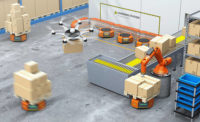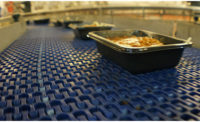We are experiencing challenging, exciting and sometimes frustrating times in the food industry. Although some activities are outside of our direct control or influence — such as the farm bill, ethanol subsidies, regulatory constraints — we are capable of shaping processes for future food manufacturing to meet the global population expansion.
As the economic status of individual consumers improves, they are consuming more protein, and as that happens, food manufacturing must evolve to meet the increased demand. Typical batch systems or piece methods are becoming extinct, necessitating the need to utilize technologies.
Transition to automated process is a natural evolution for manufacturing; whether one is assembling automobiles, harvesting animals or further-processing proteins — the progression is to make processes more efficient.
Technology continually improves, as most of us know. By the time you buy a phone, tablet or computer, a newer version is on the market in several months. Even though technology is available to our industry, its application is not always so readily accepted.
We have evolved from shadow light boxes lining up carcasses to vision systems that grade carcasses and primals. However, aren’t we just scratching the surface of how current technology will change and improve our industry?
Automated systems or processes function in the following manner. There needs to be some type of identifier, or “license plate”.
Next, the identifier has to be translated — or in “nerd” terms — receive the input data from the identifier, process the data to a predetermined outcome and then send an output signal to an end-effector or the working part of the system, by receiving the output and engaging the action. For example; a box with a bar code (identifier) on the label passes by a scanner, the information is received, sends the output to a switch which closes the circuit, which activates an air cylinder attached to a diverter arm and the box is directed to its appropriate destination.
Yet, there are actually four items needed to advance automation in our industry: the identifier, translator (interface) and end-effector, and the ability to integrate all three.
Identifiers
- Bar codes — We see bar codes mostly used in packaging. Box, bags, packages are usually identified with a bar code that can be read easily and used not only to keep inventory and production rates but to direct the location of each item. The application of bar codes is simple and reliable with only several drawbacks, such as poorly printed labels or an error from the reader.
- Optics — Optics have been used in various food-manufacturing facilities to sort out anomalies in items such as potato chips, nuts, cereals, etc. In meat production, optics have been used to determine the fat/lean interface, fat cover and depth. The downfall of some applications for optics is that any type of use would require invasive means or passing the product through a tube in which the sensor(s) would be located.
- Vision — Vision technology is one of the best technologies the meat industry is using and continues to develop. The technology can provide 3D material ratios, color contrast, surface areas, fat/lean ratios and interfaces. Some examples are the use of the beef-grading cameras, poultry-carcass scanning, and locating anatomical landmarks (spinal channel, ribs, styled meat in a tray). More applications are being developed all the time in our industry, reflecting the versatility of vision systems.
- X-ray — When one thinks of X-ray, typically it is of X-raying the human body to determine a broken bone, the condition of the lungs or some other health situation. Recent use in our industry has occurred around mapping the animal carcass in order to allow cuts and portioning to be performed. Several systems use X-rays to scan an entire lamb carcass for further-processing in an automated cutting system.
- Ultrasound— Once again, this technology primarily has been used in the medical field. Although the technology can be used and has been tested to determine fat depth or the fat/lean interface, there are a number of drawbacks. The signal device needs to be coupled to the surface as it moves over the product, a medium needs to be used to reduce friction and cold temperature affects the signal.
- RFID— Radio Frequency Identification is similar to bar-coding but adds more flexibility. There are both passive and active types of RFID. Utilization can be for trolley and carcass identification, as well as primals and finished products. Some earlier uses I can recall happened around 2002, when finished pallets had an RFID tag attached so the receiving company would be able to pass the pallet through a portal to have the boxes scanned. Another concept at that time was to have each package in a store with an RFID tag. The shopping cart would pass through a portal at the checkout counter, and all items would be read, eliminating the need to scan each item and the labor required. But one can imagine the issue that could arise with the concept.
Interfaces
- Robots — 6-axis, scarab, or simply X/Y robots are utilized in many manufacturing industries. More recently we have seen manufacturers stepping forward to meet the needs of the industry with stainless-steel robots, wash-down systems and pressurized “boots” to keep critical parts dry and provide a cleanable surface. The robots are advancing from the simple box-loaders to individual piece-placement into trays and to larger systems for the harvesting floors and processing areas.
- Belting — Advances in belting have provided more than just a transport medium for products. Surfaces, activated rollers and other devices allow belt manufacturers and users to think outside of the typical constraints that dictated belts had to be flat and straight. Surfaces are allowing various processes to be performed on products without moving the product itself. Embedded rollers, balls and hooks have been incorporated to manipulate products on the belt surfaces.
- XY table — A carcass is lying on the table. An operator can both pull and push the carcass in order to align with the cutting blade or allow the table to move the carcass. Although a simple device, an XY table or moving conveyor can provide an improvement in a process.
- Diverter/Sortation — This is another simple device, yes, but any signal received from an identifier can trigger a cylinder, open a valve or activate a plate for a belt roller. The possibilities are limitless and are widely used. Something as simple as a photo-eye or mechanical switch tripped by a trolley can divert and allow sortation based on weights, number or time.
End-effectors
- Saw — Although a saw may not seem like a very exciting topic or that it could be impacted as an end-effector, the technology that goes into saw blades will affect performance, quality and yields. Whether it is a band-saw blade or a split saw, the saw is a very good end-effector. Already in use in the automated carcass splitter or in quartering devices, expect the saw to be implemented more in the future for various roles.
- Knife — Keeping a sharp knife is a challenge for many new employees. As a useful tool, the knife as an end-effector will have to be kept sharp in order to perform the required tasks. Steeling the knife can easily be done mechanically after a certain amount of cuts or by providing a tactile response mechanism in the coupling between the end-effector and the mechanical driving device.
- Blade — An end-effector that is developed for certain cuts provides improved accuracy and resulting yields. Automated rib-puller, loin-puller and loin-trimming blades are successfully used in robotic applications today.
- Water jet — This technology has made tremendous improvements in applications in the meat industry. Originally developed for metals, the water jet has been used in further-processing in poultry for many years. Recently, more applications have taken off in the red-meat area — specifically in case-ready and the further-processing of steaks and chops. Accuracy, efficiency and reduced labor makes water-jet cutting and trimming technology and exciting area to watch as developing end-effectors.
Integration
Technology continually advances and is currently available; interfaces are readily accessible — as are end-effectors, so why aren’t plants more automated?
There are several reasons why the industry isn’t more automated, and they boil down to: the need for capital, resources and a roadmap.
Yes, technology costs. Capital is required to test a concept, and then more money is needed to develop the prototype, alpha, beta and production version. In trying to justify spending money on R&D of technology, which sometimes may not have a payback, the old mindset is, “Just buy what everyone else is using,” or, “Wait until someone else develops it, and then we will buy it.” With that type of thinking, some companies will not advance.
The need for resources doesn’t refer to the physical bar code scanner or robot, but instead to the human resource. Individuals who can create improved and new processes with technology are critical to advance automation in the meat industry. The ability to integrate technology will allow those companies engaging in it to separate themselves from competitors. Designing, testing and manufacturing new equipment to automate plants will require companies to have individuals and teams bring big ideas to life. It is also the smarter companies that will choose the correct areas to develop and advance.
Finally, as ideas are developed, there needs to be guidance, direction and a roadmap. This guide must be followed without wavering, as failure of automation is to have no plan, spend excessive capital and then when no money is left, one sees no solution. Plan the journey. Small, low-risk projects as well as medium-term projects can provide good returns while the team spends a defined amount of capital and time on longer, larger-vision projects. But always follow the map.
Conclusion
Technology is readily available, and companies in our industry have many smart people with great ideas. The key to successfully improving our industry, while making food manufacturing safer and more efficient, is to integrate technologies and ideas.
Automation is our future and those companies who embrace it will succeed, be profitable and shape our future.







